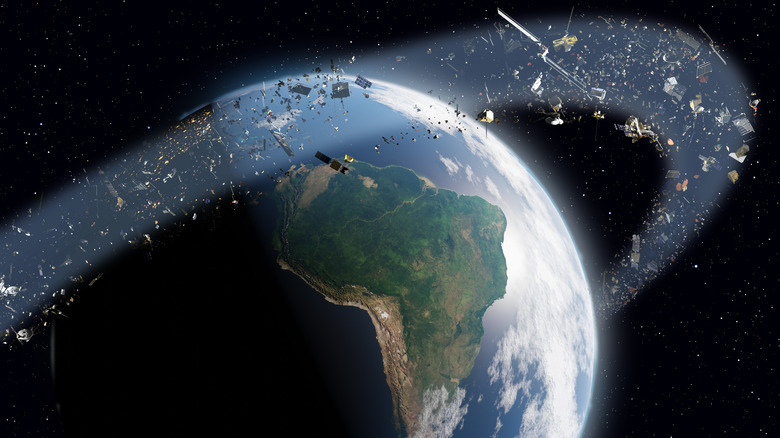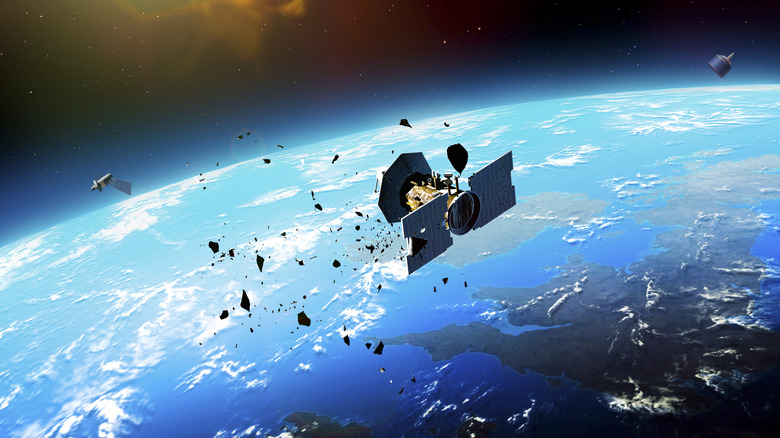How Is Space Debris Disposed Of?
One person's trash is another person's treasure, unless, of course, you're talking about space debris, since it's too tough to acquire without a shuttle or a spaceship. That's a shame because space has a huge trash problem and it got even worse in 2024, according to ESA reports. Surveillance systems currently track about 40,000 large debris fragments, with hundreds of thousands of smaller pieces floating around, too. Big, small, miniscule, every piece of debris increases the risk of high-velocity collisions. In 2021, for instance, a Chinese military satellite was struck by uncontrolled debris and exploded. The debris poses a threat not just for space shuttles and adventurers headed to explore but also satellites that support mission-critical activities back home. The crazy part: There's no plan to clean up this mess.
Basically, space debris is allowed to orbit Earth, usually for years, until it reenters the planet's atmosphere and, hopefully, burns up. The length of time each piece of debris takes to fall depends on its altitude. Objects over 600 miles away from the reentry threshold will continue orbiting around the planet for centuries. Trash is so rampant, and such a problem, that trips into low Earth orbit must factor in the probability of a collision, and the International Space Station (ISS) will even perform debris avoidance maneuvers when necessary. Although, that's certainly far from the worst thing to ever happen on the International Space Station.
But surely there's a better way to deal with all of that space garbage. A researcher and associate professor at the Graduate School of Engineering at Tohoku University in Japan may have come up with a way, using a plasma propulsion system. A removal satellite using a propulsion engine could "pull" space junk and slow it down until it falls out of orbit. It's a no-contact solution where most forms of debris removal would require contact, increasing the risk of collisions.
How would a plasma propulsion system work to remove space debris?
When the ISS has to avoid space junk twice in less than a week, that's when you know something has to be done. However, to remove junk from space, without letting it fall out of orbit naturally, would normally require direct contact. Getting too close to the garbage would increase the risk of collision, and if there are people manually removing it, someone could get hurt. If it's a robot or machine, something expensive could get damaged. Ideally, the best option is to use a no-contact, low-lift solution that doesn't expend a lot of resources. Kazunori Takahashi, the associate professor proposing the solution, believes plasma propulsion is the answer.
A removal satellite can be sent into orbit, with the explicit mission to remove garbage. Equipped with a propulsion engine, the satellite would spew plasma towards passing junk. The force the plasma creates would slow the debris, dropping it out of orbit as it decelerates, thereby speeding up the process. Instead of taking days, years, or centuries, it could take minutes.
But creating a force results in an equal reaction, in this case the plasma expulsion would force the satellite away simultaneously. That could reduce overall effectiveness. So, Takeahasi developed a "bidirectional plasma" thruster that is designed to eject the plasma in two directions, offsetting the push that would move the satellite away. To test the method, he used vacuum tubes to mimic the harsh conditions of space and let the thrusters rip. The testing found his ingenious design worked, and may even speed up deorbiting. It's not ready for real-world use yet, but this achievement does mean teams are one step closer to "developing a propulsion system capable of efficiently and safely removing space debris."

